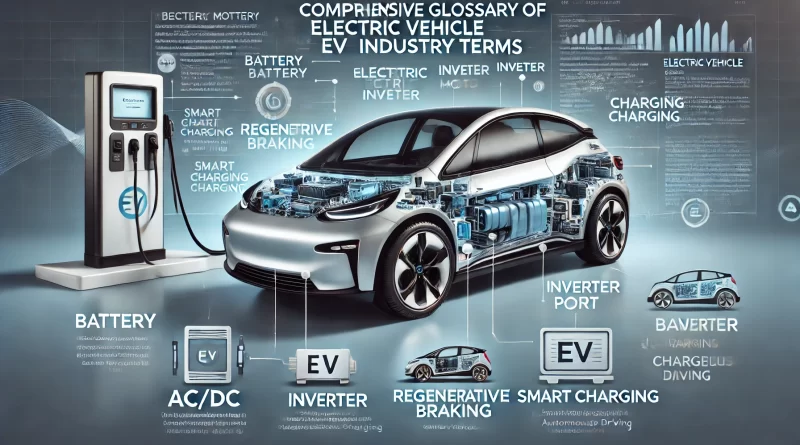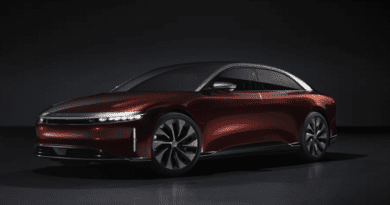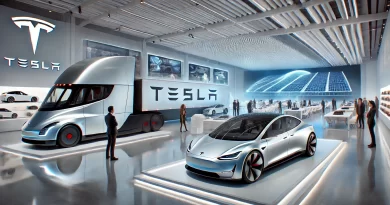Comprehensive Electric Vehicle Glossary: Terms & Definitions
Introduction
The Electric Vehicle (EV) industry is rapidly evolving, bringing with it a plethora of technical terms and concepts that can be challenging to understand. This Electric Vehicle glossary aims to provide clear and detailed definitions of the most important terms in the EV industry, helping enthusiasts, professionals, and newcomers alike to navigate this exciting field.
Glossary
Electrical Basics
- AC (Alternating Current): Alternating Current (AC) is a type of electrical current where the direction of the flow reverses periodically. It is commonly used in homes and businesses, and it’s the form of electricity delivered by power grids. AC is converted to DC (Direct Current) for storage in EV batteries.
- DC (Direct Current): Direct Current (DC) is a type of electrical current where the flow of electricity is in a single direction. EV batteries store and discharge energy in DC. Many EV components, such as the motor, may use AC, requiring converters to switch between AC and DC.
- Inverter: An inverter is a device that converts DC from the battery into AC to power the electric motor. It can also convert AC to DC for battery charging. The inverter is a crucial component in the EV powertrain.
- Electrolyte: Electrolyte is a substance within a battery that allows the flow of electrical charge between the cathode and anode. In lithium-ion batteries, electrolytes are typically liquid solutions of lithium salts.
Charging Infrastructure
- Charging Station (EVSE): Electric Vehicle Supply Equipment (EVSE) refers to the hardware used to deliver electrical energy to charge EVs. Charging stations can be categorized into Level 1, Level 2, and DC Fast Chargers, each with varying power levels and charging speeds.
- Level 1 Charging: Level 1 charging is the slowest form of charging, using a standard 120-volt household outlet. It typically provides 2-5 miles of range per hour of charging and is suitable for overnight charging at home.
- Level 2 Charging: Level 2 charging uses a 240-volt outlet, like those used for household appliances. It can provide 10-60 miles of range per hour of charging and is common in public charging stations and residential garages.
- DC Fast Charging: DC Fast Charging uses high-powered charging methods with direct current to rapidly charge EV batteries. It can provide 60-100 miles of range in about 20 minutes, making it ideal for long-distance travel and quick top-ups.
- CHAdeMO: CHAdeMO is a DC fast charging protocol and connector standard used by some EV manufacturers, particularly in Japan. It allows for high-power charging and is known for its safety features.
- Combined Charging System (CCS): The Combined Charging System (CCS) is a standardized charging protocol that supports both AC and DC charging, providing flexibility in charging options. It combines a traditional AC charger with a DC fast charger in a single connector.
- Tesla Supercharger: Tesla Superchargers are proprietary DC fast charging stations developed by Tesla. They are designed to provide rapid charging for Tesla vehicles, enabling long-distance travel with minimal charging stops.
- NACS (North American Charging Standard): The North American Charging Standard (NACS) was developed to simplify and standardize the charging process for electric vehicles in North America. It ensures compatibility and interoperability between different EV models and charging stations.
- Charge Port: The charge port is the interface on an EV where the charging cable is connected to recharge the battery. Different EVs may have different types of charge ports, compatible with various charging standards.
- On-Board Charger (OBC): The on-board charger is a device within the EV that converts AC from the charging station to DC, which is then used to charge the vehicle’s battery. The OBC determines the maximum AC charging rate of the vehicle.
Battery and Energy Management
- Battery Management System (BMS): The Battery Management System (BMS) manages the charging and discharging of the battery, ensuring it operates safely and efficiently. It monitors the state of the battery, such as voltage, temperature, and current, to prevent damage and optimize performance.
- Lithium-Ion Battery: Lithium-Ion batteries are the most common type of rechargeable batteries used in EVs due to their high energy density, long cycle life, and relatively light weight. They store and provide electrical energy to power the EV.
- Battery Capacity: Battery capacity refers to the total amount of energy that a battery can store, typically measured in kilowatt-hours (kWh). Larger capacities generally allow for longer driving ranges between charges.
- State of Charge (SOC): The State of Charge (SOC) indicates the current level of charge in an EV battery, expressed as a percentage of its total capacity. SOC is similar to a fuel gauge in a gasoline vehicle.
- Regenerative Braking: Regenerative braking is a technology that allows EVs to recover energy that would otherwise be lost as heat during braking. This energy is converted back into electrical energy and stored in the battery, enhancing efficiency and extending driving range.
- Range Extender: A range extender is an auxiliary power unit, typically a small gasoline engine, used to generate electricity to recharge the battery when it is low, extending the vehicle’s range. It is commonly used in Extended Range Electric Vehicles (EREVs).
- Smart Charging: Smart charging refers to charging technology that optimizes the charging process based on various factors such as electricity rates, grid demand, and battery health. It can help reduce costs and improve grid stability.
- Vehicle-to-Grid (V2G): Vehicle-to-Grid (V2G) is a system where EVs can communicate with the power grid to supply stored energy back to the grid. This helps balance demand and supply, and provides additional revenue streams for EV owners.
- eGallon: The eGallon metric is used to compare the cost of fueling an electric vehicle to that of fueling a gasoline-powered vehicle. It represents the cost of electricity required to drive an EV the same distance as a gasoline-powered vehicle would travel on one gallon of gasoline.
Vehicle Types and Configurations
- Electric Vehicle (EV): An Electric Vehicle (EV) is powered entirely or partially by electric motors, using energy stored in rechargeable batteries. EVs can be categorized into different types based on their powertrain configurations.
- Battery Electric Vehicle (BEV): A Battery Electric Vehicle (BEV) is powered solely by an electric battery and motor, with no internal combustion engine. BEVs rely entirely on electricity for propulsion and must be charged from an external power source.
- Hybrid Electric Vehicle (HEV): A Hybrid Electric Vehicle (HEV) combines a conventional internal combustion engine with an electric propulsion system. HEVs typically do not require external charging as the battery is charged through regenerative braking and the internal combustion engine.
- Plug-in Hybrid Electric Vehicle (PHEV): A Plug-in Hybrid Electric Vehicle (PHEV) can be charged from an external power source and can run on both electricity and gasoline. PHEVs have larger batteries than conventional hybrids, allowing for longer electric-only driving ranges.
- Extended Range Electric Vehicle (EREV): An Extended Range Electric Vehicle (EREV) primarily runs on electricity but includes a small gasoline engine to generate additional electricity once the battery is depleted, extending the driving range.
- All-Electric Range (AER): The All-Electric Range (AER) indicates the distance an EV can travel on a fully charged battery without using any auxiliary power sources like gasoline. It is a key performance metric for BEVs and PHEVs.
Performance Metrics
- Kilowatt (kW): A kilowatt (kW) is a unit of power equal to 1,000 watts. In the context of EVs, it is often used to describe the power output of the electric motor.
- Kilowatt-hour (kWh): A kilowatt-hour (kWh) is a unit of energy representing one kilowatt of power used for one hour. It is commonly used to measure the capacity of an EV battery and its energy consumption.
- MPGe (Miles Per Gallon Equivalent): MPGe is a measurement used to compare the energy consumption of electric and hybrid vehicles with traditional gasoline-powered vehicles. It represents the distance a vehicle can travel using an amount of energy equivalent to one gallon of gasoline.
Technology and Innovations
- Autopilot/Autonomous Driving: Autopilot or Autonomous Driving refers to advanced driver-assistance systems (ADAS) that enable an EV to perform some driving tasks independently. Full autonomy, where the vehicle drives itself without human intervention, is still under development.
- Connected Vehicle: A Connected Vehicle is an EV equipped with internet connectivity and communication capabilities, allowing it to interact with other vehicles, infrastructure, and networks for improved safety and convenience.
Conclusion
Understanding these technical terms is crucial for anyone interested in the EV industry, whether you’re a consumer, a professional, or an enthusiast. As the industry continues to grow and evolve, staying informed about these concepts will help you keep pace with the latest advancements and innovations.




